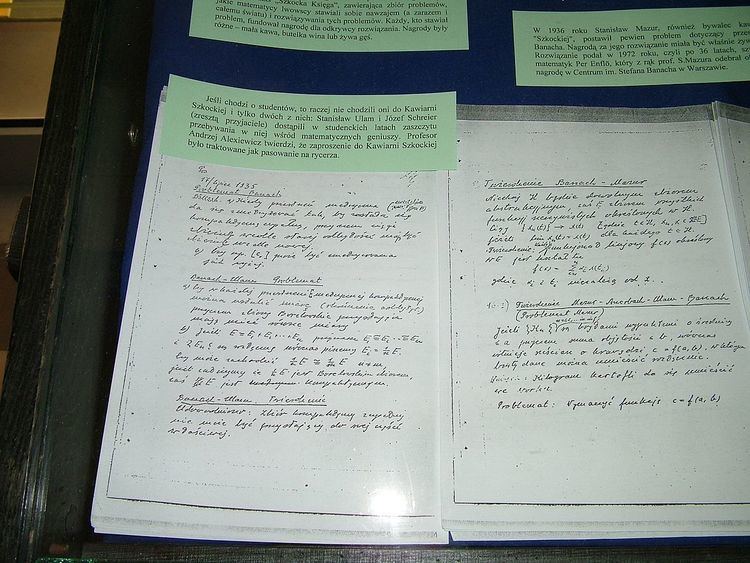 | ||
The Scottish Book (Polish: Księga Szkocka) was a thick notebook used by mathematicians of the Lwów School of Mathematics in Poland for jotting down problems meant to be solved. The notebook was named after the "Scottish Café" where it was kept.
Contents
Originally, the mathematicians who gathered at the cafe would write down the problems and equations directly on the cafe's marble table tops, but these would be erased at the end of each day, and so the record of the preceding discussions would be lost. The idea for the book was most likely originally suggested by Stefan Banach, or his wife, Łucja, who purchased a large notebook and left it with the proprietor of the cafe.
History
The Scottish Café (Polish: Kawiarnia Szkocka) was the café in Lwów (now Lviv) where, in the 1930s and 1940s, mathematicians from the Lwów School collaboratively discussed research problems, particularly in functional analysis and topology.
Stanislaw Ulam recounts that the tables of the café had marble tops, so they could write in pencil, directly on the table, during their discussions. To keep the results from being lost, and after becoming annoyed with their writing directly on the table tops, Stefan Banach's wife provided the mathematicians with a large notebook, which was used for writing the problems and answers and eventually became known as the Scottish Book. The book—a collection of solved, unsolved, and even probably unsolvable problems—could be borrowed by any of the guests of the café. Solving any of the problems was rewarded with prizes, with the most difficult and challenging problems having expensive prizes (during the Great Depression and on the eve of World War II), such as a bottle of fine brandy.
For problem 153, which was later recognized as being closely related to Stefan Banach's "basis problem", Stanisław Mazur offered the prize of a live goose. This problem was solved only in 1972 by Per Enflo, who was presented with the live goose in a ceremony that was broadcast throughout Poland.
The café building used to house the Universal Bank at the street address of 27 Taras Shevchenko Prospekt. The original cafe was renovated at May 2014 and contains a copy of the Scottish Book.
Problems contributed by individual authors
A total of 193 problems were written down in the book.
Stanisław Mazur contributed a total of 43 problems, 24 of them as a single author and 19 together with Stefan Banach. Banach himself wrote 14, plus another 11 with Stanislaw Ulam and Mazur. Ulam wrote 40 problems and additional 15 ones with others.
During the Soviet occupation of Lwów, several Russian mathematicians visited the city and also added problems to the book.
Hugo Steinhaus contributed the last one in May 1941 (other sources give March 1941), which involved a question about the likely distribution of matches within a matchbox—a problem motivated by Banach's habit of chain smoking cigarettes—shortly before the German attack on the Soviet Union.
Continuity
After World War II, an English translation annotated by Ulam was published by Los Alamos National Laboratory in 1957.
After World War II, Steinhaus at the University of Wrocław revived the tradition of the Scottish book by initiating The New Scottish Book.
Associated people
The following mathematicians were associated with the Lwów School of Mathematics or contributed to The Scottish Book:
